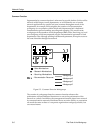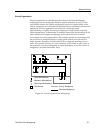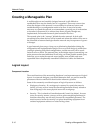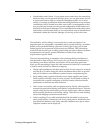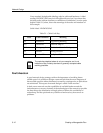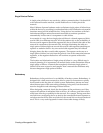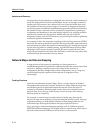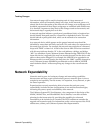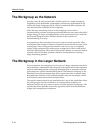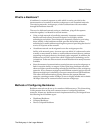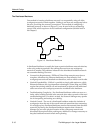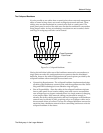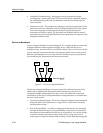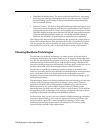
Network Design
5-14 Creating a Manageable Plan
Isolation and Recovery
No matter how much redundancy is designed into a network, and no matter how
much the single points of failure are eliminated, the law of averages eventually
catches up to any network, and a failure will occur. Once the failure does occur,
the isolation and recovery process begins. If a network is designed to eliminate
confusing layouts and make the troubleshooting procedure efficient and effective,
the amount of time a network is down is reduced. Comprehensive planning of
workgroups and backbones is the most directly effective way to design isolation
and recovery features into the network. Additionally, the use of built-in
diagnostic systems, such as LED indicators, can provide quick and easy gathering
of network operation information.
An example of this is the automatic wrapping of the dual ring structure of FDDI
networks. If a station on the dual ring is lost, the ring wraps back upon itself at the
two points between which the signal was interrupted or lost, closing the ring back
up and allowing traffic to continue passing. A good FDDI network design takes
advantage of this recovery feature by placing the most essential devices, ones
which are not intended to fail often or be shut down, on the dual ring, where they
will benefit from the automated recovery feature.
Network Maps and Record Keeping
A large portion of the process of expanding an existing network or
troubleshooting faults and problems is determining what the current state of that
network is. Keeping a running record of the status of the network, its
configuration, and any changes made to that configuration, can go a long way
toward simplifying the expansion of the network or migration to new
technologies.
Tracking Functions
Networks are inherently complex things. There is a large amount of detailed
information that needs to be recorded, and there are many different people who
need differing levels of information about the network. Since the layers of
complexity required by different people cannot always be crammed onto one
network map, it may be very useful to keep a series of maps, each showing
differing levels of complexity.
For example, a network map set might include a facility map showing the
division of areas into workgroups, a map showing the location, layout, and type
of physical cabling, one showing the locations of networking hardware, and
individual maps showing the locations and types of physical devices.
If you are using a network management package, such as Cabletron Systems
SPECTRUM Element Manager, it is helpful to have a network map which shows
the MAC addresses and IP addresses of the devices on the network.



